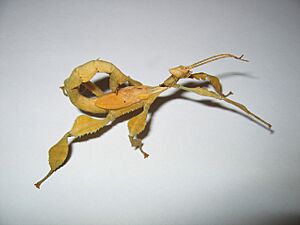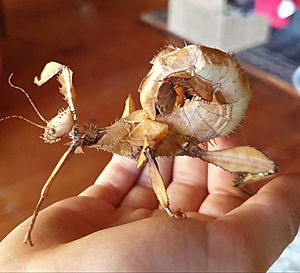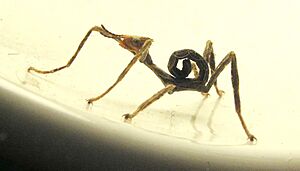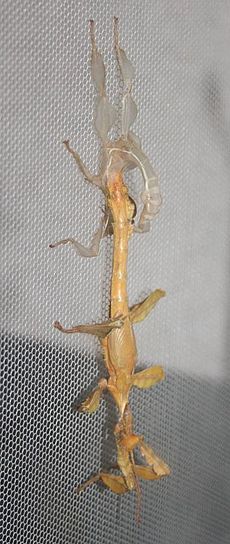Spiny leaf insect facts for kids
Extatosoma tiaratum, also known as the giant prickly stick insect, the spiny leaf insect, or the Australian walking stick, is a large type of stick insect. It is found only in Australia. This amazing insect is also known by its special number, PSG9, given by the Phasmid Study Group.
Quick facts for kids Extatosoma tiaratum |
|
|---|---|
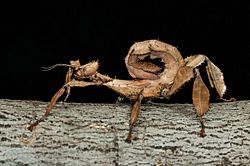 |
|
| E. tiaratum | |
| Scientific classification | |
| Kingdom: | |
| Phylum: | |
| Class: | |
| Order: | |
| Family: | |
| Subfamily: | |
| Genus: | |
| Species: |
E. tiaratum
|
| Binomial name | |
| Extatosoma tiaratum (Macleay, 1826)
|
|
Contents
Where Do Prickly Stick Insects Live?
E. tiaratum naturally lives in Queensland and New South Wales in Australia. You can also find them as far away as New Guinea.
What Do Prickly Stick Insects Look Like?
Female E. tiaratum are covered with thorn-like spikes. These spikes help them hide and protect themselves. Their long, rounded bodies can grow up to 8 inches (20 cm) long. Females have small wings that are too tiny for them to fly, especially when they are carrying eggs.
Differences Between Males and Females
Like many insects, male and female prickly stick insects look quite different. This is called sexual dimorphism. Males are smaller and thinner, growing to about 4.3 inches (11 cm) long. They do not have many thorny growths, except for some spikes around their faces.
Males have long wings and are good at flying. They will fly away quickly if something bothers them or if they are looking for females.
How Do Prickly Stick Insects Protect Themselves?
Prickly stick insects have cool ways to protect themselves from animals that might want to eat them.
Threat Behavior
When they feel threatened, both male and female stick insects will strike a special pose. They stand up on their front and middle legs, pointing their abdomen (the back part of their body) up or to the side. This looks a bit like a scorpion's pose.
If something touches their abdomen, they can quickly snap their back legs together. The sharp spines on their legs can even poke human skin! Adult stick insects also make clicking sounds. They can release a smell that reminds people of toffee to scare away predators. Males might also flash their wings open to startle an attacker.
Amazing Camouflage
E. tiaratum uses both passive and active camouflage to blend in. They often hang upside down among leaves, curling their spiky bodies to look like part of the plant.
These insects come in many colors, like brown, green, reddish, cream, yellowish, or even white. This helps them match their surroundings.
When there is a breeze or if they are disturbed, E. tiaratum will sway back and forth. This movement looks just like leaves rustling in the wind. This swaying helps them avoid being seen by predators. It makes them look like a plant, not a tasty snack!
Life Cycle and Reproduction
E. tiaratum usually reproduce through sexual reproduction, meaning a male and female are needed. The eggs hatch about four months later.
Parthenogenesis
If there are no males around, these stick insects can still lay eggs! This is called parthenogenesis. Eggs laid without a male can take up to nine months to hatch. These eggs will only produce female stick insects.
Laying Eggs
In both cases, the female "flicks" her eggs away from her body. She swings her tail, sending the eggs several feet to land on the forest floor. These eggs need to be kept fairly cool, below 77 °F (25 °C), or they might not hatch.
The outside of E. tiaratum eggs has special fats and other natural chemicals. Ants think these chemicals are food. They carry the eggs to their colony, eat the outer part, and then dump the rest of the egg in their waste piles. Luckily, for stick insects kept as pets, the ants eating the outer layer is not needed for the eggs to hatch.
Young Stick Insects
When E. tiaratum eggs hatch, the young insects are called nymphs. These nymphs look like ants! This is called ant mimicry. Their bright orange head, white collar, and black body make them look like a type of ant called Leptomyrmex. This makes them seem toxic to predators.
While adult stick insects are usually slow, these young nymphs are very fast and active. They quickly move to the trees. As they grow and shed their skin (called moulting), they become slower. Female nymphs also get their spiky look through these moulting stages.
Caring for Prickly Stick Insects
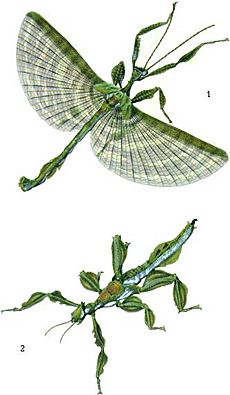
These stick insects are quite popular as pets and are often kept in schools for projects. They are also used in labs for studies. If you want to keep two adult females, you need a cage that is at least 24 inches (60 cm) high and 12 inches (30 cm) deep and wide.
Even though their eggs take many months to hatch, these insects lay a lot of eggs. You can sometimes hear the eggs clicking against the glass of their terraria as the female flicks them away.
Female E. tiaratum usually live for about 18 months. Males live for a shorter time, only about 6 to 8 months.
What Do Prickly Stick Insects Eat?
E. tiaratum are herbivores, meaning they only eat plants. In their natural home, they love to eat Eucalyptus leaves.
If you keep them as pets, they can also eat leaves from plants like bayberry, bramble, hawthorn, oak, photinia, raspberry, rose, and salmon berry. While they can live on these other leaves, they might not grow as big or have the same natural colors as those that eat Eucalyptus.
Images for kids


